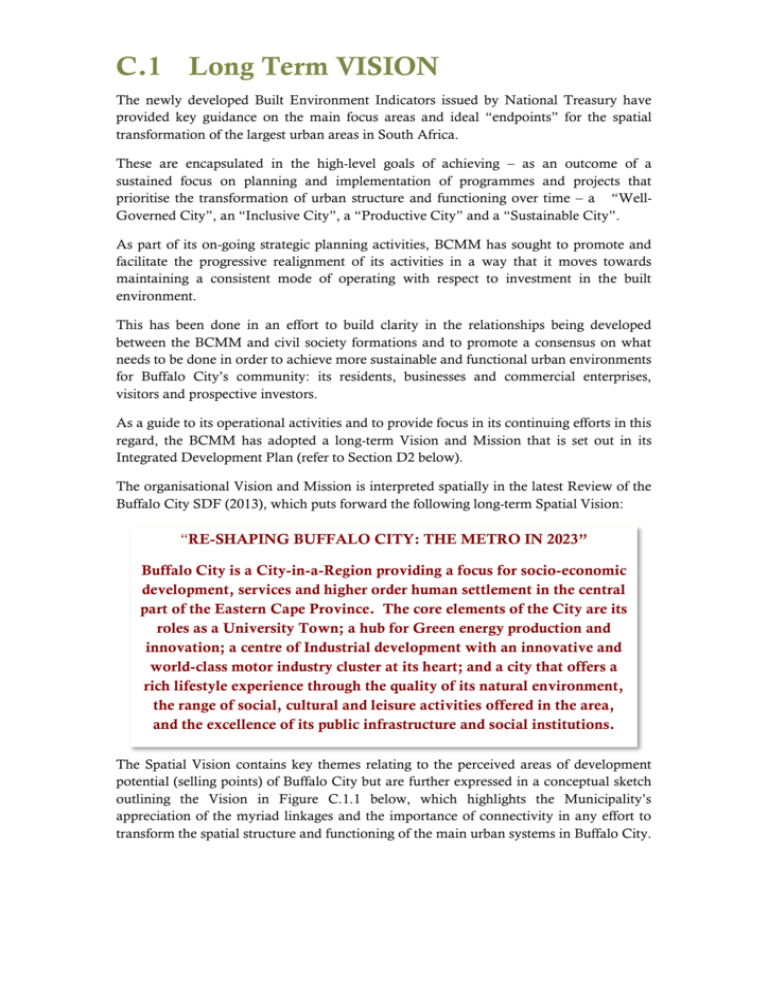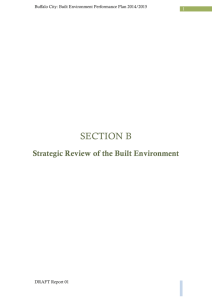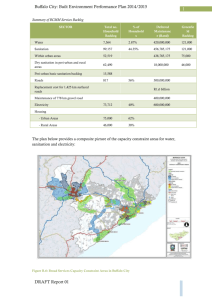BCM BEPP Draft 01_January 2014 - PART 04 - NDP
advertisement

C.1 Long Term VISION The newly developed Built Environment Indicators issued by National Treasury have provided key guidance on the main focus areas and ideal “endpoints” for the spatial transformation of the largest urban areas in South Africa. These are encapsulated in the high-level goals of achieving – as an outcome of a sustained focus on planning and implementation of programmes and projects that prioritise the transformation of urban structure and functioning over time – a “WellGoverned City”, an “Inclusive City”, a “Productive City” and a “Sustainable City”. As part of its on-going strategic planning activities, BCMM has sought to promote and facilitate the progressive realignment of its activities in a way that it moves towards maintaining a consistent mode of operating with respect to investment in the built environment. This has been done in an effort to build clarity in the relationships being developed between the BCMM and civil society formations and to promote a consensus on what needs to be done in order to achieve more sustainable and functional urban environments for Buffalo City’s community: its residents, businesses and commercial enterprises, visitors and prospective investors. As a guide to its operational activities and to provide focus in its continuing efforts in this regard, the BCMM has adopted a long-term Vision and Mission that is set out in its Integrated Development Plan (refer to Section D2 below). The organisational Vision and Mission is interpreted spatially in the latest Review of the Buffalo City SDF (2013), which puts forward the following long-term Spatial Vision: “RE-SHAPING BUFFALO CITY: THE METRO IN 2023” Buffalo City is a City-in-a-Region providing a focus for socio-economic development, services and higher order human settlement in the central part of the Eastern Cape Province. The core elements of the City are its roles as a University Town; a hub for Green energy production and innovation; a centre of Industrial development with an innovative and world-class motor industry cluster at its heart; and a city that offers a rich lifestyle experience through the quality of its natural environment, the range of social, cultural and leisure activities offered in the area, and the excellence of its public infrastructure and social institutions. The Spatial Vision contains key themes relating to the perceived areas of development potential (selling points) of Buffalo City but are further expressed in a conceptual sketch outlining the Vision in Figure C.1.1 below, which highlights the Municipality’s appreciation of the myriad linkages and the importance of connectivity in any effort to transform the spatial structure and functioning of the main urban systems in Buffalo City. Figure C.1: BCMM Spatial Vision 2023 It is recognised that the achievement of the Spatial Vision requires the spatial alignment of planning and project implementation to develop the infrastructure networks (capacity) and linkages in the areas of greatest priority, as defined in the strategic approach set out below. C.2 The Spatial Development Strategy of BCMM Within the Buffalo City area the following spatial pattern of development characterises the current status of land use and settlement: The dominant East London - King William's Town - Dimbaza urban axis. This spatially defines a principal development corridor that services the greater Amatole region. The peri-urban fringe and rural settlement area. This component includes the Newlands settlements, settlements that previously fell within the former Ciskei 'Bantustan', and the Ncera rural settlements located west of East London. The commercial farming areas confined mainly to the north-eastern and south-western (coastal) sectors. These areas are characterised by both extensive and intensive agricultural land utilisation. The settlement pattern demonstrates spatial fragmentation continuing to occur within East London and King William's Town, mostly in the form of class-segregated residential areas or dormitory suburbs. Some larger such areas include Mdantsane, Potsdam, Ginsberg, Zwelitsha, Phakamisa, Breidbach and Ilitha. In addition, the higher order function and natural growth of the historic towns of East London and King William's Town have been impacted by attempts to create satellite or "buffer strip" residential, commercial, industrial and administrative growth nodes - i.e. Bhisho, Berlin and Dimbaza. The City recognises such spatial development pattern as a legacy of apartheid and previous Bantustan policies that require urgent attention. In terms of the BCMM IDP, an overall concept (described below) is accepted and endorsed as strategic direction provided by the Municipal Council for the purposes of this BEPP. “In essence, the approach of Building on Urban and Rural Strengths acknowledges that the urban areas of Greater East London/Mdantsane and King William’s Town/Bhisho are likely to be focal points for significant economic growth and development within Buffalo City over an extended period of time. However, it is accepted that there is a dependency amongst a significant proportion of the residents of Buffalo City on access to peri-urban and/or rural land for basic livelihood (i.e. survival or subsistence) purposes, and that this is likely to continue to be so, at least in the medium term (10 years). Therefore, it is concluded that: It must be accepted that it is most rational and economically effective to focus higher order development investment (in infrastructure, housing and a diversity of economic enterprises) in the urban core areas. However, a proportion of the resources of BCMM must also be targeted in areas of opportunity and areas of need in fringe rural and peri-urban areas, in order to upgrade existing settlements and create or facilitate new development opportunities in these areas.” As noted above, from a conceptual point of view, the urban portion of Buffalo City extends in a linear form along the main watershed between East London and King Williams Town, with the historical settlements and urban nodes using the main roads and railway line as the main transport route to the surrounding area. This urban form can be simply described as ‘beads on a string’ and, in order to enhance the operational effectiveness of this built form, it is envisaged that future development should be directed in such a way that the various settlements or nodes (beads) along the main rail and road transport routes (or string) be allowed to develop in intensity (i.e. density and variety or mix of land uses). This is intended to create areas where the density of development and the increased variety of opportunities at points of good access to the majority of residents would improve both the overall functioning of the built environment in Buffalo City, as well as offer better social and economic opportunities for the residents. More specifically, it is suggested that within areas of high need and/or development potential, the integration of modes of transportation, particularly public transportation modes, should be undertaken to create points of high accessibility for a greater number of people. For the purposes of the Buffalo City Metropolitan SDF, then, the central development concept is one of ‘beads on a string’, with the string comprising a linear system of integrated movement modes and the beads being the intensive mixed-use nodes, around multi-modal transportation terminals. An alternative (or more technical) description of the concept would be to focus on the concepts of nodes (beads) and corridors (string). There can be no doubt that an efficient transport system is fundamental for the successful development of the City. The greater the integration between development and the road, rail and modes of transport, the more opportunities there will be for economic development. This implies a need to develop intense and higher density settlements with mixed uses along the main transport routes; inner city medium density residential environments surrounding the East London and King William’s Town CBD’s and medium density residential development not more than 120 meters from bus/taxi routes and near stations. The rural areas, which contain agricultural/residential mixed uses, would be located in suitable areas where water soils and topography could sustain ‘urban agricultural environments’. It is further proposed that market garden living environments be supported where commercial scale agriculture could be sustained. Such a conceptual framework would enable a close relationship to develop between urban and rural settlements. There is a danger that urban sprawl could erode valuable agricultural land if it continues unchecked. Accordingly, it is believed essential that increased densities close to transport and economic centres are a vital strategy and new investment in housing, commercial buildings, industrial sites and recreation facilities should be used to increase the intensity of land use within the confines of the existing urban area and thereby raise living densities, improve public transport viability and increase economic activity. Investment in public facilities can also be used as development facilitators through the development of intensive mixed use nodes and creation of ‘community bundles’ containing public facilities, community services and sports infrastructure. Through this conceptual framework of integrating development closely with efficient transport systems, an improved environment is expected for the future city. In order to achieve such a future vision, certain key spatial structuring elements need to be used in all development decision making to direct growth and ensure the city starts to re-direct development into a framework which is more appropriate and desirable. C.2.2 Broad Spatial Development Strategies In response to the conceptual framework above, the reviewed Spatial Development Framework for Buffalo City Metropolitan Municipality elaborates objectives and strategies to manage spatial development and land use and to guide new investment to achieve the development vision set out in the BCMM IDP and the SDF. The core strategic approach is summarized as follows: Implement the principles of Integrated Environment Management and identify resources (natural/biodiversity; social; economic; heritage and cultural; human capital; financial) and manage land use in valuable resource areas; Use a defined Urban Edge and Land Use Management System as spatial management and investment guidance tools; Consolidate and integrate spatial development by developing land in proximity to public transport facilities and existing services; Implement a Land Reform and Settlement Programme by identifying zones of opportunity or integrated development in peri-urban and rural areas; Pro-actively manage land use and set appropriate levels of service to achieve sustainability in urban, peri-urban and rural areas. C.3 Overview of Area-Based Initiatives Buffalo City has three area-based initiatives, at present. These are: The Mdantsane Urban renewal Programme (MURP The Duncan Village Redevelopment Initiative (DVRI) The Bhisho-King William’s Town Revitalisation Programme The following details apply: 1. The Mdantsane Urban Renewal Programme (MURP) Specific areas of focus for the Urban Renewal Programme include: The upgrade or rehabilitation of existing but degraded infrastructure; The redevelopment of key access and circulation roads within the township; The development of social facilities in facility clusters at strategic localities within the township; and The development of public transport feeder routes to the railway stations. It is also proposed that the funding streams administered in terms MURP are to be used to target specific development areas including: Consolidation of fragmented formal and informal settlement areas on the western fringe of the township, including areas known as Unit P, Ikhwezi, Khayelitsha (Potsdam East NU 1), Potsdam Village (Blue Rock), Unit V and Potsdam South. Development of Reeston Phase 3 on the eastern side of Mdantsane. Upgrade and redevelopment of settlements in the Mdantsane Buffer Strip to achieve higher residential densities, particularly in localities near to strategic transport modal interchanges such as Mount Ruth and Mdantsane Stations. Co-ordinated upgrade of infrastructural capacity and the prioritization of some 10,000 informal shacks in serviceable areas within the built fabric of Mdantsane. The Mdantsane CBD (known locally as “Highway”) is a Regional Transport Hub for taxis and buses, but poor linkages to the railway stations located along the northern fringe of the township hinder the potential for integrated modal public transport systems at present. In the context of Buffalo City, Highway is a relatively minor Commercial Service Centre – it serves the township but operating thresholds are low (low densities and little disposable income). Many people prefer to commute to East London for goods and services. MELD proposals for intensification of land use around Highway are important if the node is to be developed to its potential. 2. The Duncan Village Redevelopment Initiative (DVRI) The main focus of the DVRI is to establish formal housing in an area that is almost entirely covered by informal settlements. This focus is also in line with the National Upgrading Support Programme (NUSP), which aims to facilitate the upgrading of informal settlements in South Africa. As part of the National Programme on the Upgrading of Informal Settlements, an Interim Business Plan was prepared by BCMM and submitted to the Provincial Department of Human Settlement. The Total Interim Project Budget contained in this Interim Business Plan amounts to over R1billion, with a project timeframe of 15 years. 3. The Bhisho – King William’s Town Revitalisation Programme In 2010 the Department of Roads and Public Works commissioned the implementation of a Master Plan for Bhisho Revitalisation. The Master Plan proposed the revitalization of Bhisho through a number of strategic projects that can be implemented by public and private sector delivery agents. A number of Anchor Projects categorised into term periods have been identified. These include the following: Quick Win Projects (< 2 Years) Upgrading of Bhisho Memorial Pedestrianisation of portion of Independence Avenue Waste Recycling Signage Marketing and Communication Strategy Short to Medium Term Projects (2-5 years) Strategic Spatial Implementation Framework Bhisho CBD Upgrade and Parking Strategy Independence Avenue Ceremonial Boulevard New Office Precincts: Phase 1 Residential Development (Social, Rental and Gap / Affordable Housing) Long Term Projects (+5 years) Office Precinct Affordable and Bonded Housing Partially subsidised Rental Social Housing, High value privately funded housing projects) CBD Upgrading (Public realm and existing retail facilities) Sports, Recreational and Caravan Park Upgrading into a Multi-Purpose Node C.3.1 Co-Ordination with Special Infrastructure Projects The Special Infrastructure Project (SIP) applicable in Buffalo City is the SIP 7: Integrated Urban Space and Public Transport Programme. This section will be expanded when the projects and programmes for the 2014/2015 MTREF period have been refined and adopted by Council. C.3.2 Co-Ordination and Alignment with Informal Settlement Upgrade Programme With the support of the National Department of Human Settlements, funding has been made available through the National Upgrading Support Programme (NUSP) to support BCMM’s programme to carry out in-situ upgrade procedures in 32 informal settlements, which are located (with the exception of one settlement) within the SDF-designated Priority Areas (Integration Zones) of Greater East London-Mdantsane (Priority Area 1) and King William’s Town/Bhisho (Priority Area 3a). C.3.3 Land Release and the Spatial Development Strategy In 2012, Buffalo City Municipality BCM invited the Housing Development Agency (HDA) to deliberate on strategic areas of support. Accordingly, the Implementation Protocol (IP) was drafted and the Medium Term Operation Plan (MTOP) has been finalised to commit the parties to act in common pursuit of the stated aims and objectives in keeping with the provisions of the Intergovernmental Relations Framework Act. The objectives and priorities of the Protocol are: – i. to authorise the Agency to facilitate the process of Land Assembly and Tenure upgrading on behalf of the BCM so as to enable the Municipality to undertake development; ii. Specifically, through the Implementation Protocol, the BCM appoints the HDA to fulfil the following role, namely: act as its duly authorised agent and representative to identify, acquire transfer land required for development purposes in line with the SDF of the municipality Priorities to be pursued are set out in this operational plan as confirmation of collaboration and is the basis of specified roles, funding arrangements and performance expectations agreed by the BCM and the HDA.






